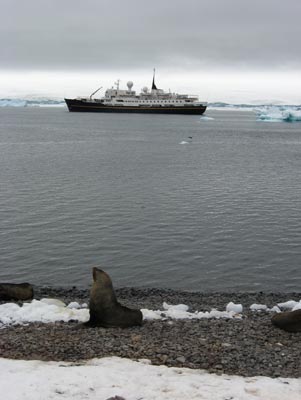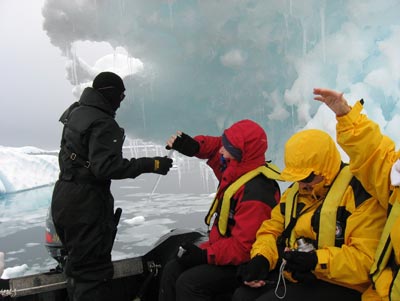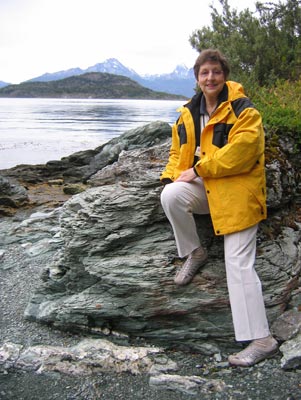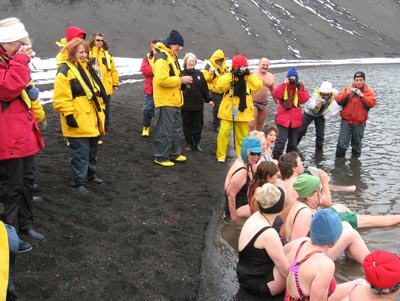Voyage to Antarctica
by Glenna Lybrand, Mount Ida, Arkansas
A visit to Antarctica helped me realize a lifelong dream: to travel to every continent on Earth. The vast frozen wilderness of the White Continent boasts gleaming ice-blue glaciers and abundant wildlife. It is a mystical land with blazing icescapes of luminous intensity and a haunting beauty that defies oral or pictorial description.
Choosing a cruise
My trip began in February ’07 when I, along with my travel friend Betty Prince, joined a group of 80 participants for a 16-day cruise-tour with Grand Circle Travel (Boston, MA; 800/221-2610, www.gct.com). It was only after much research that I chose this particular trip with Grand Circle, because of the price, the company’s reputation and the numerous inclusions.
The tour, which cost from $6,470 depending on the type of cabin selected, included international and domestic flights; all accommodations, including two nights in Buenos Aires and one night in Ushuaia; 33 meals, and sightseeing tours in Buenos Aires, Ushuaia and Tierra del Fuego National Park.
After two nights in Buenos Aires and an overnight in Ushuaia, our 9-day cruise aboard the M/S Andrea began. The Andrea was a lovely, well-arranged ship with a friendly crew. The food on board was excellent, and wine was complimentary at both lunch and dinner.
The expedition team consisted of seven well-traveled and adventurous guys with astounding knowledge and expertise in their various fields. Also with us on the trip were four representatives from Grand Circle Travel.
Betty and I shared a spacious cabin on deck six. With three large windows facing outside and a deck nearby, we were always able to see the beauty of the majestic world around us.
Getting ready to go ashore
After leaving the Beagle Channel and Cape Horn behind us, we faced the daunting 2-day crossing of the infamous Drake Passage, where oceans collide. This passage is notorious for having some of the most turbulent waters on the planet. Thankfully, our passage, according to the crew, was relatively smooth.
After two days and nights on the ship, we eagerly awaited, albeit with some trepidation, our first Zodiac landing, on Penguin Island, one of the South Shetland Islands.
The suggested attire for landings included silk undies; a layer of thermal wear and/or polar fleece; regular pants and shirt; a warm cap; waterproof pants; a hooded parka; two to three layers of socks (one of them woolen); knee-high Wellington boots; thin gloves plus waterproof gloves or mittens, and a provided inflatable life jacket. At least 20 minutes was required to get into all of our gear before waddling to the loading deck.
On the warm day of this first landing, we found all of this clothing to be too much, but at other times it felt good.
Surprisingly, the weather in the Antarctic summer (December-February) was relatively warm, with daytime temperatures ranging from 23 to 54 degrees Fahrenheit. However, it was the windchill (as low as -20) that cut to the bone.
For each landing, the ship anchored within sight of the intended destination. Passengers loaded into the Zodiacs, about eight to 10 people in each. Since there are no seats inside these rubber crafts, passengers sit on the wide rounded sides.
Upon each arrival, we experienced a “wet landing,” meaning that we had to swing our bodies around on the side of the Zodiac and let ourselves down into the water (with help from the crew) before walking ashore. With lots of slippery rocks below, that wasn’t always easy.
It was on our landing at Penguin Island that Betty fell and broke her wrist. She was airlifted to the mainland, where she received medical attention before flying back home. Fortunately, we had purchased insurance that covered most of her expenses. (Grand Circle offers excellent insurance through TripMate.) Unfortunately, she missed seeing all the glorious wonders of this unique land.
Arctic animals
On the third day we reached the mainland of Antarctica. We awoke to a sea of floating ice — some small, some as tall as skyscrapers. From this point onward, the captain and his bridge crew had to exercise constant vigilance to avoid hitting icebergs or getting into areas the ship could not navigate.
Our itinerary called for two Zodiac landings each day. Each landing site offered a variety of terrain and wildlife. We saw four types of penguins: gentoo, chinstrap, Adélie and macaroni. Seals were common at most land sites, including fur, crab-eating, Weddell and elephant seals. Each landing also gave us opportunities to observe a variety of seabirds.
My favorite part of the trip was when we were taken on Zodiac cruises among the icebergs. With all the sizes, variety and colors of the bergs, as well as all the icicles and other formations on them, it was overwhelmingly beautiful! During these cruises, we also saw lots of seals floating on ice floes and minke whales cavorting in the water.
The penguins won my affection with their tentative waddling and their intense curiosity. Although we were instructed to get no closer than 15 feet from them, we could lie, sit or kneel nearby and allow them to approach us. While I was kneeling on one knee, a young gentoo walked around and under me, pecking at a loose strap and closely examining my water bottle.
The only unpleasant aspect of their presence was the proliferation of penguin poop, noted for its potent putrid odor. At each landing, the crew brought ashore what they called a “guano-matic,” a rigged device consisting of three large brushes secured to a board. Before leaving a landing, each passenger was required to clean his boots before boarding the Zodiac. An inadequate cleanup would result in a stinky cabin.
Braving the weather
One morning we awoke to a one-inch cover of snow on the deck, ice frozen on windows, and a raw and cloudy day outside.
The itinerary for the day included landings at Devil Island and Snow Hill Island, but our plans to go ashore had to be canceled because the ship could not get close enough to Devil Island. The expedition team, therefore, arranged another Zodiac cruise through ice floes and under icicle-bedecked bergs.
February 26 was our worst weather day. The wind was blowing at 40 knots and the temperature was 23° with a chill factor of -20. But, as promised on our schedule, we went ashore at an Argentine base called Esperanza.
In the Zodiacs, we almost froze as we made our way across the channel through blowing snow and icy winds. We arrived at a cluster of rusty-red metal buildings located on a rocky, windswept mountainside, where several Argentine families, totaling 40 to 50 people, live year-round.
One afternoon landing provided a rare opportunity to experience a polar plunge at Deception Island. Deception is a beautiful circular island with an 8-mile-wide water-filled volcanic caldera inside the circle.
To enter this haven of black sandy beaches, ships must maneuver Neptune’s Bellows, a narrow gap in the island’s wall where violent winds sometimes blow across the mouth of the entrance. To further complicate matters, a submerged rock lies only a few feet below the surface in the middle of the entrance.
After the ship anchored safely inside the caldera, Zodiacs took us to a black-sand beach. It was here that several hearty souls swam in a spot of warm water created by subterranean geothermal activity.
Planning your trip
Here are a few tips for anyone planning to visit Antarctica.
• Purchase your gear early. Query your travel company regarding what is needed and what is furnished. (Grand Circle provided excellent parkas for our trip.) Knee-high boots and waterproof pants are essential for the wet landings. Sierra Trading Post (www.sierratradingpost.com) often has weatherproof pants and other necessary items on sale.
• Take two seasick-prevention patches for the two Drake Passage crossings. They’re well worth the money!
• Take only necessary items. Life on board the ship is very casual. You can wear the same clothing each time for Zodiac landings.
• Get the best cabin you can afford on the ship. So much can be seen constantly if you have windows and a deck nearby. By paying early for my trip, I was offered a free upgrade.
• Carry as little as possible on the landings, which last only one to two hours, and plan to have both hands free for getting in and out of the Zodiac. I used a small bag with a long strap that went over my head and hung across my body to hold everything I needed, leaving my hands free.
• Consider and reconsider taking a telescoping walking stick with a pointed end. (Several people on the trip used these.) Although I took one along, I used it only once. It did not help my balance, and it impeded my entering and exiting the Zodiac.
Summing up
On Feb. 28, our exploration of the White Continent had come to an end. Once again we experienced a couple of days of rock-and-roll as we crossed the Antarctic Convergence and the Drake Passage. Our return route took us past Cape Horn, through Beagle Channel and back to Ushuaia, where we bade farewell to our crew and expedition team.
When asked about my trip to Antarctica, I like to reply with a quote by the explorer Sir Ernest Shackleton: “It’s the last great journey left to man.”
Because of the uniqueness of Antarctica, this trip was not comparable to any other trip I have taken during 25 years of travel to 70 countries. One must experience for oneself the vastness, the beguiling silence, the awesome grandeur of this seventh continent.






